A closer look: Screening for synthetic diamonds using standard gem instruments
by charlene_voisin | February 1, 2014 9:00 am
By Branko Deljanin
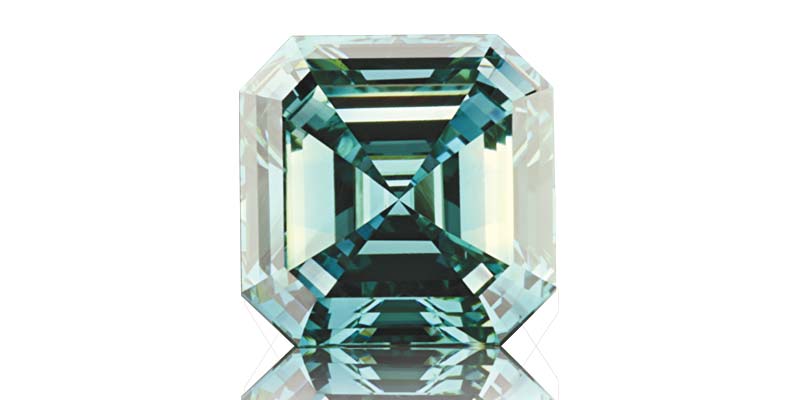 [1]
[1]
In the last few years, several high-profile incidents of parcels salted with synthetic diamonds have put the industry on high alert. They have also spurred gemmologists and others to develop new tools for identifying lab-grown stones.
The goal of this article is to provide gemmologists, appraisers, dealers, and retailers with screening processes using standard instruments (i.e. ultraviolet lamp and microscope in combination with polariscope) to help identify origin, or at the very least, to flag suspected lab-grown diamonds for further testing at an advanced lab.
Diamond types
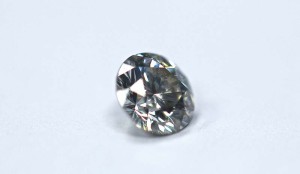 [2]
[2]Diamonds are typically classified into four categories: Type Ia, Type IIa, Type Ib, and Type IIb. Type Ia and Type Ib indicate the relative presence of nitrogen (N), while Type IIb refers to the presence of boron (B). Type IIa diamonds are considered the rarest of diamonds due to their absence of impurities.
Approximately 97 per cent of natural diamonds are considered Type Ia. These can occur in all colours, although brown, ‘cape’ yellow, and near-colourless are the most common. Blue diamonds are classified as Type IIb, accounting for only 0.1 per cent. Less than one per cent of all diamonds are Type Ib ‘canarian’ orangey-yellow to brown diamonds, while two per cent of all diamonds are Type IIa colourless, brown, and pink.
Synthetic diamonds are created using high pressure, high temperature (HPHT) or carbon vapour deposition (CVD). These processes can produce near-colourless Type IIa diamonds, yellow to orange Type Ib, pink Type Ib or IIa (after annealing and irradiation), and blue Type IIb. As such, identifying approximate diamond type can help in the initial screening for natural or synthetic origin. Using a method discussed further on in this article, one can look for birefringence, which is present in natural diamonds. The absence of birefringence or very weak expression of this effect can indicate that a diamond was grown quickly through a man-made process.
Determining exact diamond type is done by means of a Fourier transform infrared spectroscopy (FTIR) in a well-equipped gem lab. This tool can also conclusively identify a synthetic diamond when used in combination with visible and photoluminescence spectrometers.
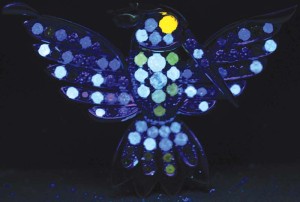 [3]
[3]Alexei Zarakhani, owner of Advanced Optical Technology Co. (AOTC) in Ottawa, says most of the HPHT diamonds his company produces are sold in North America. “There is high interest in blue and colourless lab-grown diamonds, so we have almost stopped production of yellow and pink diamonds,” he explains. “Approximately 60 per cent of our production is blue and the rest is colourless, the vast majority being VS clarity.”
AOTC reports more than 50 per cent of the diamonds it created in 2004 and 2006 were VS quality or better, and colourless production in those years totalled one per cent and five per cent, respectively. The results suggest lab-grown near-colourless diamonds are improving in quality and gaining popularity in the marketplace.
Most lab-grown diamonds are smaller than one carat and very common in sizes less than 10 points. Given most melee is never sent to advanced labs to test for origin, it is likely that finished jewellery on the market today comprises lab-grown smalls. To make matters worse, identifying mounted melee synthetics is difficult even with advanced spectroscopic instruments.
Screening using optical instruments
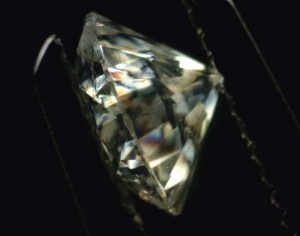 [4]
[4]Using cross-polarized filters (CPF) is one method wholesalers, appraisers, or retailers can use to help screen for diamond types and flag suspected synthetic stones for further testing at an advanced lab.
Diamond is an isotropic material (i.e. it displays the same properties in all directions), exhibiting birefringence, an anomalous double refraction (ADR) effect also known as ‘strain.’ This phenomenon can occur due to plastic deformation, elastic deformation near inclusions, and growth striations, among other reasons, and is manifested as an effect called ‘interference colours.’ The greater the difference between refractive indices, the more intense the interference colours appear to be. Since Type Ia diamonds have more impurities than Type IIa, their birefringence is stronger.
It is important to note birefringence is a very stable effect in diamonds and cannot be removed using currently available technologies, such as annealing, HPHT, or irradiation. The CPF method is relatively simple and inexpensive to set up, and only requires a set of linear polarization filters (or portable polariscope) attached to any microscope. To use the CPF method, position the suspected synthetic between the cross-polarized filters and rotate it in transmitted light to observe birefringence. (ADR is a 3-D effect and has to be observed from all directions).
Different diamond types and subtypes can exhibit various birefringence under CPF.
- Low-nitrogen natural diamonds often have a typical ‘tatami’ pattern (i.e. fine intersecting parallel dislocations). Type IIa brownish colour stones and Type IaB can be improved using HPHT without irradiation to colourless and near-colourless or pink. Once treated, these colours are stable.
- Though weak and difficult to observe, a ‘smudgy pattern’ is a strong indication a diamond is a natural Type IaAB (i.e. cape series), which is the most common type of near-colourless to yellow diamond. Cape samples can be colour-treated to be more intense and, therefore, more desirable.
- High pressure, high temperature is the most common method to grow synthetic diamonds—it takes two days to create a one-carat stone. Unlike natural diamonds that are exposed to pressure as they are pushed to the surface in kimberlite pipes, synthetic stones are free of the plastic deformation this process produces. Absence of any birefringence under CPF is confirmation of synthetic origin of Type Ib (yellow, pink), Type IIa diamond (colourless), and Type IIb (blue) grown using HPHT.
- Based on co-operative research between our lab and GemResearch Swisslab (GRS), we know CVD diamonds created by Scio Diamonds exhibit a ‘columnar structure’ under cross-polarized filters, as they are grown in layers on the seed. The new generation of CVD diamonds produced by Gemesis and Washington Diamonds are usually HPHT-treated to improve colour. Since these synthetics can exhibit a very weak pattern similar to natural Type IIa diamonds, additional standard (UV lamp) and advanced (photoluminescence spectroscopy) tests are necessary to confirm synthetic origin.
Screening melee using UV lamp
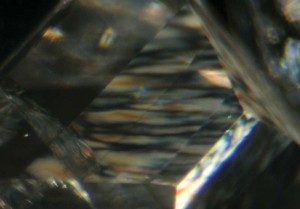 [5]
[5]In most cases, applying the CPF method to mounted diamonds is not feasible. Instead, testing for fluorescence is another useful tool for set diamonds, as well as loose.
In diamonds, fluorescence is an optical phenomenon in which the molecular absorption of photons triggers the emission of visible light when exposed to UV light. In the case of 95 per cent of natural diamonds, fluorescence is seen as blue. Most colourless and coloured natural diamonds react stronger at long-wave UV and usually weaker (mostly blue) at shorter wavelengths.
The following describes how different types of diamonds fluoresce under long-wave (LW) and short-wave (SW) UV light:
None: in Type IIa and Type IaA natural diamonds, the aggregate (i.e. two nitrogen atoms) tends to extinguish fluorescence (LW none and SW none).
Blue: caused by three nitrogen atoms at 415nm in Type IaAB natural diamonds (LW > SW).
Yellow: caused by hydrogen impurities in Type IaAB natural diamonds (LW > SW).
Bluish-green: caused by boron impurities in Type IIb and Type IIa HPHT-grown diamonds (SW > LW).
Yellowish-green: caused by a nickel catalyst in Type Ib HPHT-grown diamonds (SW > LW).
Orange: observed in Type IIa brownish/pinkish/near-colourless CVD-grown diamonds (SW > LW).
Greenish-blue: seen in Type IIa colourless CVD-grown and post HPHT-treated diamonds (SW > LW).
Orangey-red: observed in Type Ib HPHT-treated pink diamonds (strong LW = strong SW).
Though rare, other colours of fluorescence are possible in natural low-nitrogen diamonds (e.g. pink and red). It is important to note that although mounted melee and small sides can be tested for fluorescence, this must be done in an absolutely dark room and under high magnification using a UV lamp mounted on a microscope.
No pain, no gain in diamond identification
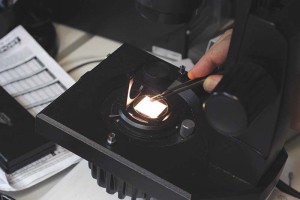 [6]
[6]Visually, natural and synthetic diamonds can look very similar when comparing size, cut, colour, and clarity. Yet, their commercial values differ significantly, which highlights the importance of detection and disclosure. For instance, coloured synthetics can cost 50 to 60 per cent less than their natural counterparts. In the case of colourless lab-growns, the price difference is around 25 to 30 per cent.
Many dealers and retailers believe diamonds exhibiting medium, strong, or very strong blue fluorescence are inferior. However, visible strong blue fluorescence under long-wave light is a very strong indication of a diamond’s natural origin.
In combination with the simple CPF method, the fluorescence technique can be used to screen for diamond types and help identify synthetic origin of a coloured diamond, as well as colourless without pattern (i.e. HPHT), even with diamonds less than .50 carats.
However, in cases where the diamond is determined Type IIa based on the ‘tatami’ pattern, it is still very important to refer it to an advanced lab to determine whether colour is natural or HPHT-enhanced, or the stone is CVD-grown.
The procedures explained here are relatively simple, easy to learn, and inexpensive. A CPF set and UV lamp costs about $500. In light of several occurrences of salted parcels of undisclosed diamonds reported in the last few years, vigilance and an understanding of gemmological tools are critical to ensuring confidence in the supply line.
The author is grateful to Willy Bieri (GemResearch Swisslab [GRS]) and Bill Vermeulen (CGL-GRS Canada) for their contribution to this article.
 [7]Branko Deljanin, B.Sc., GG, FGA, DUG is head gemmologist and director of CGL-GRS Swiss Canadian Gemlab Inc., in Vancouver. He is a regular contributor to trade and gemmological magazines, and has presented reports at a number of research conferences. Deljanin is an instructor of standard and advanced gemmology programs on diamonds and coloured stones in Canada and internationally. He can be reached at info@cglworld.ca[8].
[7]Branko Deljanin, B.Sc., GG, FGA, DUG is head gemmologist and director of CGL-GRS Swiss Canadian Gemlab Inc., in Vancouver. He is a regular contributor to trade and gemmological magazines, and has presented reports at a number of research conferences. Deljanin is an instructor of standard and advanced gemmology programs on diamonds and coloured stones in Canada and internationally. He can be reached at info@cglworld.ca[8].
- [Image]: http://www.jewellerybusiness.com/wp-content/uploads/2014/02/Gem_92392205D.jpg
- [Image]: http://www.jewellerybusiness.com/wp-content/uploads/2014/02/Gem_Fig-4-Scio-CVD-grown-Colorless-diamond-in-most-popular-size-of-natural-diamond-0.50-carat.jpg
- [Image]: http://www.jewellerybusiness.com/wp-content/uploads/2014/02/Gem_Fig-10-Huming-bird-under-LW-UV-light-Natural-diamonds-showing-weak-to-strong-reaction.jpg
- [Image]: http://www.jewellerybusiness.com/wp-content/uploads/2014/02/Gem_Fig-6b-CPF-of-type-Ia-diamond-where-high-biregrigence-or-strain-indicate-natural-origin.jpg
- [Image]: http://www.jewellerybusiness.com/wp-content/uploads/2014/02/Gem_Fig-8-Columnar-pattern-under-CPF-of-Scio-CVD-grown-Type-IIa-diamond-indicates-that-diamond-is-grown-by-deposition-GRS-lab-credit.jpg
- [Image]: http://www.jewellerybusiness.com/wp-content/uploads/2014/02/Gem_Fig-5-CGL-PICTURE-pink-diamond-of-uknown-originbetween-cross-polarized-filters-on-microscope.jpg
- [Image]: http://www.jewellerybusiness.com/wp-content/uploads/2014/08/Branko.jpg
- info@cglworld.ca: mailto:info@cglworld.ca
Source URL: https://www.jewellerybusiness.com/features/a-closer-look-screening-for-synthetic-diamonds-using-standard-gem-instruments/